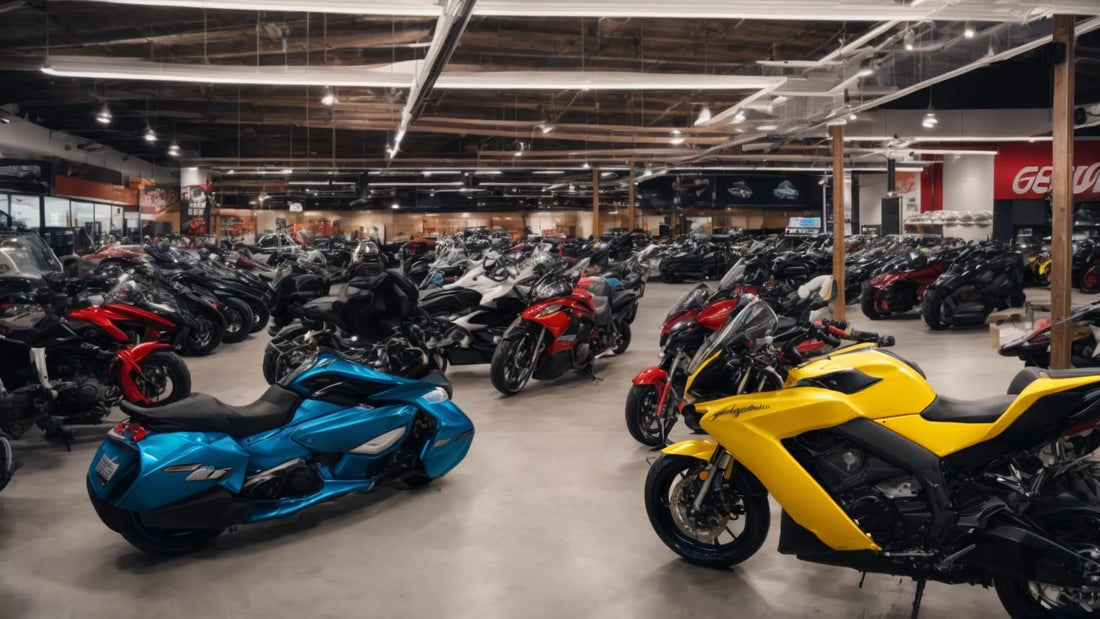
PowerSports Industry Outlook: Navigating Autumn 2024
Jeremy KuehniShare
PowerSports Industry Outlook: Navigating the Winds of Change in Autumn 2024
The PowerSports industry, encompassing a thrilling array of vehicles such as motorcycles, ATVs, snowmobiles, and personal watercraft, has surged forward in recent years. This dynamic sector has witnessed a remarkable upswing driven by a confluence of factors, including a renewed appreciation for outdoor recreation, a growing desire for adventure, and the enduring allure of the open road. As we approach Autumn 2024, the PowerSports landscape continues to evolve, presenting both exciting opportunities and significant challenges for manufacturers, retailers, and enthusiasts alike. This article delves into the key trends shaping the industry, exploring the headwinds and tailwinds that will influence its trajectory.
A Deeper Dive into the PowerSports Landscape: Autumn 2024
The PowerSports industry is a fascinating microcosm of societal shifts and technological advancements. Understanding the key trends shaping this industry is essential for anyone seeking to navigate its evolving landscape. Here are some of the most prominent factors that will impact the PowerSports market in Autumn 2024:
1. The Enduring Appeal of Adventure and Recreation:
The pandemic's impact on the PowerSports industry has been profound and enduring. As people sought to escape the confines of their homes and reconnect with nature, the demand for PowerSports vehicles soared. This surge in interest was fueled by a growing appreciation for adventure and recreational pursuits, with many discovering the joys of riding motorcycles, exploring trails on ATVs, or experiencing the thrill of snowmobiling. The pandemic underscored the inherent human desire for freedom, exploration, and connection with the natural world, fueling a renewed interest in outdoor activities. This trend, particularly strong among younger generations, suggests that the demand for PowerSports experiences will remain robust in the coming years.
The PowerSports industry has effectively tapped into this growing demand by offering a wide range of experiences and activities, from adrenaline-pumping off-road adventures to scenic road trips and leisurely lake excursions. This versatility has attracted a diverse range of individuals, from seasoned veterans to newcomers eager to embrace the thrill of riding. The industry has also played a key role in promoting responsible outdoor recreation, emphasizing safety practices and environmental awareness among its enthusiasts.
2. The Technological Revolution in PowerSports:
The PowerSports industry is not immune to the relentless march of technological innovation. Manufacturers are constantly pushing the boundaries of engineering, integrating cutting-edge technologies into their vehicles to enhance performance, safety, and the overall riding experience. This includes the adoption of electronic throttle control, advanced traction control systems, sophisticated digital instrument panels, and connectivity features that allow riders to seamlessly integrate their vehicles with their smartphones and other devices.
The integration of these technologies is transforming the way people interact with their PowerSports vehicles, creating a more engaging and user-friendly experience. Riders can now monitor their vehicle's performance in real-time, adjust settings on the fly, and stay connected with their surroundings through advanced navigation systems. The integration of smartphone connectivity has also opened up a world of possibilities, from accessing music and navigation apps to tracking performance data and sharing ride experiences with friends.
One of the most exciting technological advancements in the PowerSports industry is the emergence of electric powertrains. Electric motorcycles, ATVs, and snowmobiles are gaining traction, offering a compelling alternative to traditional gasoline-powered vehicles. These electric models offer several advantages, including near-silent operation, instant torque, reduced emissions, and lower maintenance costs. As battery technology continues to improve, offering longer ranges and faster charging times, electric PowerSports vehicles are poised to play an increasingly prominent role in the industry. The growing popularity of electric vehicles reflects a broader societal shift towards sustainability and the desire for cleaner and more efficient transportation options.
3. A Greener Future for PowerSports:
The PowerSports industry is increasingly aware of its environmental impact, and manufacturers are responding by taking concrete steps towards sustainability. This includes a focus on developing more fuel-efficient engines, exploring alternative power sources such as electric propulsion, and implementing sustainable manufacturing practices throughout the supply chain. These efforts are driven by both consumer demand for environmentally friendly products and the growing pressure from regulatory bodies. This trend towards sustainability is not only a matter of environmental responsibility but also a strategic imperative for manufacturers who want to appeal to a growing segment of environmentally conscious consumers.
The adoption of hybrid powertrains is another significant step towards sustainability in the PowerSports industry. These systems combine the efficiency of electric motors with the range and power of gasoline engines, offering a balance between performance and environmental responsibility. Manufacturers are also investing in lighter materials and more aerodynamic designs to further improve fuel efficiency and reduce emissions. The transition to sustainable practices is not only a matter of environmental responsibility but also a strategic imperative for the long-term success of the PowerSports industry.
4. The Power of Diversity in the PowerSports Market:
The demographics of PowerSports enthusiasts are evolving, breaking free from traditional stereotypes. The industry is witnessing a growing number of women and families embracing PowerSports activities, a shift that is challenging traditional norms and opening up new opportunities for manufacturers. In response to this evolving market, manufacturers are developing models and accessories that cater to a broader range of riders, including women-specific apparel, family-friendly vehicles, and a greater emphasis on accessibility and inclusivity.
The PowerSports industry is recognizing that a diverse and inclusive community is essential for its long-term growth and sustainability. By embracing diversity and creating products and experiences that appeal to a wider range of consumers, the industry can expand its market reach and create a more welcoming and engaging environment for all enthusiasts. This shift towards inclusivity reflects a broader societal trend towards greater diversity and representation in all areas of life.
Challenges and Opportunities in the Autumn 2024 PowerSports Market:
While the PowerSports industry is experiencing a surge in demand and innovation, it also faces a number of challenges that will require careful navigation. These challenges, however, also present opportunities for those who are able to adapt and innovate.
Challenges:
- Rising Costs: The global economic landscape is characterized by rising inflation and supply chain disruptions, which have driven up the cost of raw materials, labor, and transportation. These pressures have forced manufacturers to increase prices, which can impact consumer demand, particularly in a competitive market. Manufacturers will need to find creative ways to manage costs without compromising on quality or performance. This may involve exploring alternative materials, streamlining production processes, and negotiating favorable terms with suppliers. Additionally, manufacturers may consider offering more affordable entry-level models to cater to budget-conscious consumers.
- Supply Chain Disruptions: Global supply chain issues, exacerbated by the pandemic and geopolitical tensions, have led to shortages of key components and materials. This can delay production and delivery times, impacting sales and customer satisfaction. Manufacturers are seeking to diversify their supply chains, build stronger relationships with suppliers, and invest in new technologies to mitigate the effects of disruptions. This includes establishing alternative sourcing options, fostering closer partnerships with suppliers, and implementing advanced inventory management systems. Manufacturers can also leverage technology to enhance supply chain visibility and responsiveness, allowing them to quickly adapt to changing market conditions.
- Evolving Consumer Preferences: Consumer preferences are constantly evolving, driven by factors like technology, sustainability, and affordability. Manufacturers need to adapt their product offerings and marketing strategies to meet these changing demands. This includes embracing new technologies, incorporating sustainable practices, and offering a wider range of price points to cater to diverse budgets. Manufacturers can also focus on developing products that align with consumer values, such as prioritizing safety, comfort, and environmental friendliness.
- Competition from Other Recreation Activities: The PowerSports industry is not operating in a vacuum. It faces competition from other recreational activities, such as hiking, camping, and water sports. Manufacturers need to ensure that their products and experiences offer unique value propositions that differentiate them from other options. This includes highlighting the benefits of PowerSports, such as the freedom, adrenaline, and social connections it provides, and marketing their products effectively to target audiences.
- Regulatory Landscape: The PowerSports industry is subject to a complex web of regulations, including those related to safety, emissions, and noise pollution. Manufacturers must comply with these regulations while continuing to innovate and develop new products. This requires careful planning, collaboration with regulators, and a commitment to staying informed about the latest regulations and guidelines.
Opportunities:
- Growing Global Market: The PowerSports industry is experiencing significant growth in emerging markets, particularly in Asia and South America. Manufacturers have the opportunity to tap into these new markets by adapting their products and marketing strategies to local preferences. This includes understanding cultural nuances, tailoring products to local needs, and establishing strong distribution networks to reach consumers in these regions. Manufacturers can also leverage their existing global presence to expand into new markets, leveraging their brand recognition and established distribution channels.
- Digital Transformation: The rise of e-commerce and online marketing presents opportunities for manufacturers and retailers to reach wider audiences. Investing in digital platforms and marketing strategies can help drive sales, build brand awareness, and create deeper connections with consumers. This includes leveraging social media, search engine optimization (SEO), content marketing, and targeted digital advertising to reach the right consumers at the right time. Manufacturers can also use digital platforms to provide customers with interactive experiences, such as virtual test drives, product configurators, and online communities.
- Innovation and Technology: PowerSports manufacturers have an opportunity to differentiate themselves through innovation and technology. By developing cutting-edge features, enhancing safety systems, and incorporating sustainable solutions, they can attract and retain customers in a competitive market. This includes investing in research and development, collaborating with universities and technology companies, and staying ahead of the curve in terms of technological advancements. Manufacturers can also explore new materials, design concepts, and powertrain technologies to create innovative and exciting products that meet the evolving needs of consumers.
- Focus on Safety and Education: The PowerSports industry has a responsibility to promote safety and educate riders about responsible riding practices. By investing in safety features, offering training programs, and partnering with organizations that promote safe riding, manufacturers can enhance the overall experience for riders and contribute to the long-term health of the industry.
- Partnerships and Collaboration: The PowerSports industry is built on collaboration. Manufacturers can benefit from partnering with other businesses, including retailers, service providers, and tourism operators, to create integrated experiences for consumers. This can include joint marketing initiatives, cross-promotional campaigns, and the development of shared infrastructure and resources. By collaborating with other stakeholders, manufacturers can expand their reach, enhance the customer experience, and drive industry growth.
Riding into the Future: The PowerSports Industry in Autumn 2024
The PowerSports industry is at a pivotal point in its evolution. It is a sector driven by passion, adventure, and the pursuit of new experiences. The trends shaping this industry in Autumn 2024 present both challenges and opportunities. Those who are able to navigate these winds of change, embracing innovation, sustainability, and a commitment to meeting the evolving needs of consumers, will be well-positioned to thrive in this dynamic and exciting sector.
The PowerSports industry is more than just a collection of vehicles; it's a community of enthusiasts who share a passion for the open road, the thrill of adventure, and the freedom of the ride. As the industry continues to evolve, it's this shared passion that will drive its success and ensure that the spirit of adventure continues to ignite imaginations for generations to come.
